Click here for Group Reservations How To
Click here for Groups Navigation
Group Tabs | |
|---|---|
| Leaders | |
| Group Functions | |
|---|---|
| Add | Payment Tabs |
Tabs Available for Groups
The basic master information on all types of masters are similar. Each master type has different tabs available where appropriate. As shown in the sample Group Master, tabs outlined in color hold master-specific information. 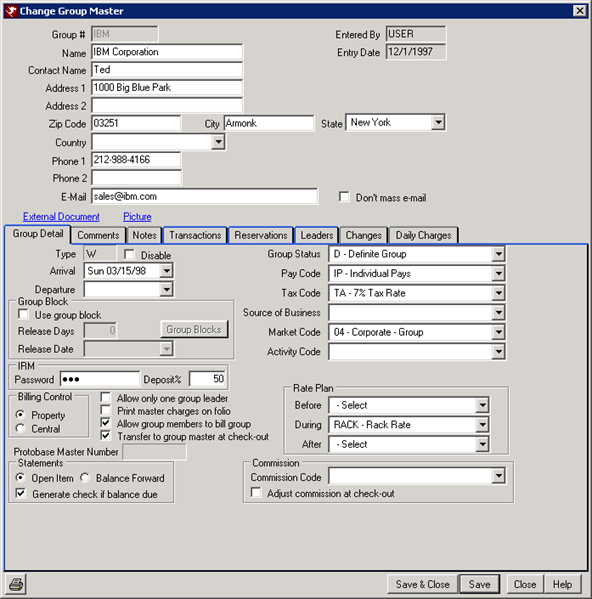
Contact Detail
When viewing the Analysis screen with a group selected, the groups contact and origination information are displayed on the Contact Detail tab. The actual tab does not display when Add or Change Group screens are accessed; however, the fields are displayed above the other tabs.
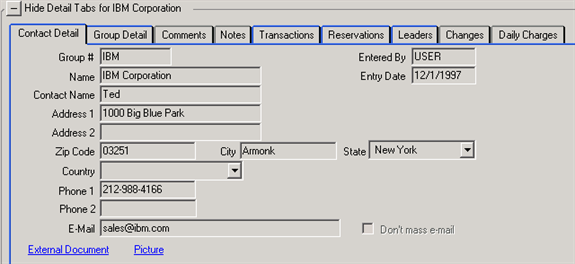
- Group#
- Enter or maintain the 8-alphanumeric characters representing the group number.
- Entered By
- When a group master is added to the database, this field is stamped by the system to identify the logon name of the user who entered the information.
- Name
- Enter the name of the group using any 24 alphanumeric characters.
- Entry Date
- When a group master is added to the database, this field is stamped by the system to identify the system date when the information was entered.
- Address 1 and 2
- Enter the street (mailing) address of the group using any 24 alphanumeric characters.
- City
- Enter the city where the group is located using any 16 alphanumeric characters.
- State
- Select the state where the group is located using the drop-down list. When the first letter of the desired state is typed in to the field directly, the system searches the CB table and displays the closest match. Once a state is displayed in this field, use the up and down arrows to scroll through the list individually without using the mouse.
- Zip
- Enter the Zip Code using any 10 alphanumeric characters prior to the City and State fields for the system to automatically fill in those fields for the user. Letters are allowed for Canadian and European addresses.
- Country
- Select the country where the group is located using the drop-down list. When the first letter of the desired country is typed in to the field directly, the system searches and displays the closest match. Once a country is displayed in this field, use the up and down arrows to scroll through the list individually without using the mouse.
- Home and Business
- Enter the home and business telephone numbers of the group using any 12 alphanumeric characters. Formats allowed are 800/555-1212, 800-555-1212, 8005551212, and 011945551212.
- Enter the email address of the group using any 40 alphanumeric characters. The system recognizes that an e-mail address must contain the "@" symbol and displays an error when not entered.
- Don't Mass E-mail
- Check to allow the group to opt out of mass e-mail marketing. Allowing this restriction abides by all current regulations for anti-SPAM.
- External Documents - T2 Module Required
- This link allows external files to be attached to the group master. Use this feature to attach detailed information about the group. The following file types are supported: Txt, Doc, Docx, Htm, Html, Xls, Jpg, Bmp, Gif, and more. The documents can be viewed as long as the workstation has the application installed that displays that file extension.
- To attach a file, save it to the \RDP\RDP<xx>\MasterDocs\Group folder, using the group master number as the file name. For example, if the file created was for the group IBM in the RDP01 directory, the file and location would be \RDP\RDP01\MasterDocs\Group\IBM.doc (the file extension will change based on the program it was created in).
- If more than document is needed for the master, enter the master number followed by 1, 2, 3, etc. For example, for group number 101, enter the file name as 101-1, 101-2, 101-3, and a prompt appears allowing the different files to be selected.
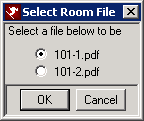
- If the file does not exist, the following error message will appear with the file path location when the link is clicked. Note: The file location will display the UNC path, however, the file can be saved to the RDP drive (usually R:\ or F:\).
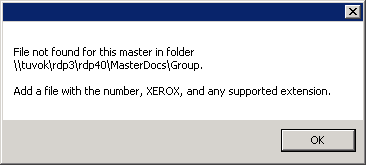
- External Picture - T2 Module Required
- This link allows external pictures to be attached to the group master. The following file types are supported: Txt, Doc, Docx, Htm, Html, Xls, Jpg, Bmp, Gif, and more. The pictures can be viewed as long as the workstation has the application installed that displays that file extension.
- To attach a picture, save it to the \RDP\RDP<xx>\MasterPics\Group folder, using the group master number as the file name. For example, if the file created was for the group IBM in the RDP01 directory, the file and location would be \RDP\RDP01\MasterPics\Group\IBM.jpg.
- If more than picture is needed for the master, enter the master number followed by 1, 2, 3, etc. For example, for group number 101, enter the file name as 101-1, 101-2, 101-3, and a prompt appears allowing the different pictures to be selected.

- If the file does not exist, the following error message will display showing the file path location when the link is clicked. Note: The file location will display the UNC path, however, the file can be saved to the RDP drive (usually R:\ or F:\).
- Note: The External Documents and Pictures feature requires the T2 Module. For more information about this module, contact RDP Sales.
Group Detail Tab
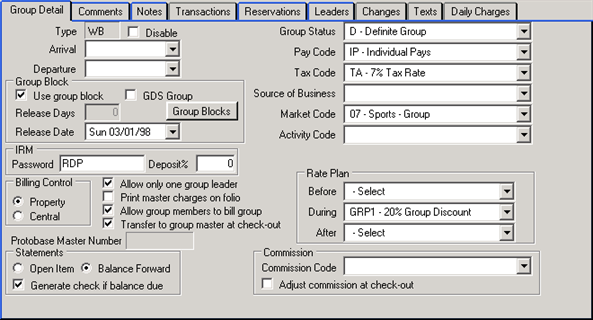
- Type
- The type is dependent upon whether a room block is needed for the group. Groups with no room blocks assigned are type W and groups with a room block are type WB.
- Disable Checkbox
- When checked, the group master does not display on the Find or Analysis screens to allow a more narrow search on active groups. Once disabled, a group cannot be added to a reservation. All existing reservations with a disabled group are unchanged.
- Arrival Date / Departure Date
- For groups with a block, enter the arrival and departure date for the block. These dates are used to release the block as well as assign rate plans before, during and after a group member's stay. Only enter an Arrival Date and a Departure Date, if the group does not repeat during the same year. The Arrival Date should be the earliest date any member is arriving and the Departure Date should be the latest date any member is leaving.
- Use a Group Block
- When checked, a room block can be assigned to this group, the
group type is changed to WB, and Release Days/Date fields are
enabled. When not checked, the House block
is used for all reservations for the group and the type is W.
Use the room Block section of the Group Detail tab to set define group blocks. Check the "Use a Group Block" checkbox to enable the Release Days and Release Date fields. Set the Release Days to designate the block as the type to release based on a specific number of days from the current system date. Set the Release Date to designate the block to be released into inventory on a specific date. Click the Room Blocks button to view, add, and remove rooms/types from the group block.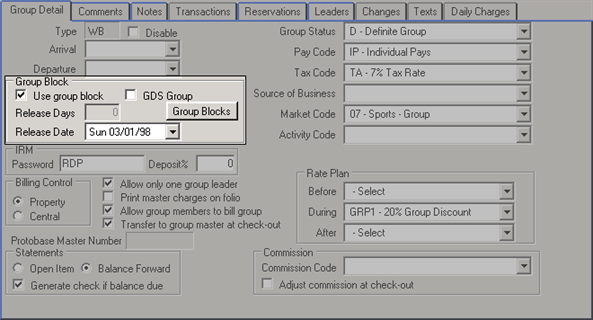
- GDS Group
- Check when the group is a GDS provider. The GDS provider cannot be configured until a group master is first established. Once created as a group, the GDS provider is available in the Group sections of the GDS Configuration.
- Release Days
- Room blocks can be released a number of days prior to the current system date. Enter the number of days here. Either Release Days or Release Date can be set; but not both.
- Release Date
- The system releases the room block back into inventory on a particular date. Either Release Days or Release Date can be set; but not both.
- Room Blocks Button
- Click this button to display and or change the Adjust Room Blocks information.
- Password
- Groups that allow reservations to be made on the Internet Reservation Module (IRM) can assign a password to allow any member of the group access the IRM and make a reservation. Group members must enter their group number and password to make reservations online.
- Deposit Percentage
- If a group is allowed to make reservations on the IRM, a deposit can be automatically calculated for each reservation. The deposit amount is calculated as this percentage of the room charge on the reservation.
- Billing Control
- If using the Upload/Download Central Reservation feature from RDP, designate whether central reservations or the property where the guest stays bills the group. The default setting is Property.
- Allow Only One Group Leader
- Check to insure that more than one group leader cannot be designated within a group.
- Allow Group Members to Bill Group
- When checked, group member charges may be billed to the group master. For any direct bill group, this must be checked. If the group is never to have any billing, uncheck this box. The default for this setting is Switch 419-01.
- Print Master Charges on Folio
- When this box is checked, master charges are printed on the folio.
- Protobase Master Number
- In order to take credit card deposits with Protobase, a unique numeric identifier is needed. The group number field cannot be used because it must be numeric only; not alphanumeric. When a group is added or changed, RDPWin automatically assigns a unique number to the master record.
- Group Status (Table GS)
- The group status defines where in the group's life cycle the group resides:
- T - Tentative: A tentative group is allowed to have a room block, but no reservations may be made.
- V - Definite Verbal: The system allows reservations to be made.
- D - Definite: As soon as a contract is signed, a group should be changed to Definite.
- X - Cancelled Group: Group is no longer booking rooms.
- Pay Code (Table C7 or FS)
- In most cases, billing should be done at the group leader level, so this pay code should be IP. If this is a company rather than a group that sends employees to the property over a period of time and wants a statement reflecting activity and a balance due, enter the default pay code here. The pay code can be adjusted on each individual reservation. If all group members stay at the same time, the billing should always go to the Group Leader. Otherwise, the billing should go to the Group Master.
Long Term reservations can also be used as a group leader. However, group members are not allowed to bill to that group leader. The group leader pay code for the group members is always IP (Individual Pay). - Tax Code (Table C7)
- Select the default tax code for reservations for this group. The group tax code overrides any room tax code.
- Source of Business (Table CD)
- Enter the default Source of Business code for this group. Individual reservations can be changed if needed. Source of Business Code is blank by default when adding a new group. When Switch 425-19 "Is Source of Business Code Required" is set to Yes for RDPWin, then Source of Business is required to save a new group.
- Market Code (Table CF)
- Enter the default market code for this group. Individual reservations can be changed if needed. Market Code is blank by default when adding a new group. When Switch 425-18 "Is Market Code Required" is set to Yes for RDPWin, then Market Code is required to save a new group.
- Activity Code (Table VG)
- If the IRM Virtual Store (Module S1) is installed, this is the batch of activities allowed for this group when reservations are made on the IRM.
- Rate Plan (Table Z0) Before
- Enter the default rate plan for the group to be used for reservations made before the arrival date (i.e., if block arrival/departure date3s are 05/01-05/08, any reservation made before 05/01 would receive the designated rate plan in the Before field). Rate plans can be changed when making the reservations if necessary.
- Rate Plan During
- Enter the default rate plan (required field) for the group to be used for reservations made on or after the arrival date and on or before the departure date (i.e., if block arrival/departure dates are 05/01-05/08, any reservation on/after 05/01 and on/before 05/08 would receive the designated rate plan in the During field). Rate plans can be changed when making the reservations if necessary.
- Rate Plan After
- Enter the default rate plan for the group to be used for reservations made to extend after the departure date (i.e., if block arrival/departure dates are 05/01-05/08, any reservation dates after 05/08 would receive the designated rate plan in the After field). Rate plans can be changed when making the reservations if necessary.
- Statements - Open Item vs. Balance Forward
- Only two types of group masters should receive statements: (1) a company that sends employees to the property
over a period of time, and (2) an entity or individual with a "house account" such as a catering/conference
room use. Open Item statements display any outstanding reservations until payment is received and applied
against the reservation. Balance Forward statements lump all past activity into one balance and carry it
forward to the next billing period. Balance Forward statements should be used for house accounts, since
there will never be any room reservations attached.
If a group statement should reflect all "open" reservations (those with a balance), select the Open Item radio button. If the statement should reflect the amount due at the end of the last billing period plus all new activity, select the Balance Forward radio button.- Generate Check if Balance Due
- If checked and if money is owed to the group when the statement is closed, a check is generated. If not checked, any money owed to the group after the closing of a statement must be generated outside of the RDP system.
IRM
Comments Tab
The twelve comment fields can be customized to the property's needs and
are defined in Tables JA to JL. Common information tracked in these fields include billing arrangements, alternate contacts, and number of rooms requested. The headings for these fields can be changed to reflect the appropriate information. Depending on which master type is selected determines how many comment fields are available.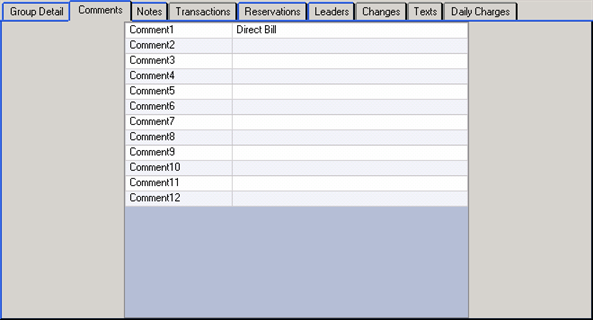
Notes Tab
Any free text entries pertaining to the selected master are displayed in this section.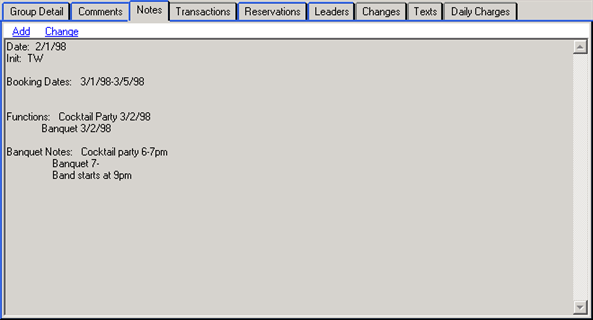
Transactions Tab
Display a grid with complete transaction history for the selected group, as well as a tally of the charges for current the period. Click the Post Charge button to open the Post Charge form or Change to access the Change/Reverse Charges form. Fields displayed on this tab are transaction date, transaction code, description, price, quantity, charge, tax, total, no print, and running balance. Check the Display All Transactions box to display all historical transactions for the selected master (time consuming). When not checked, filter the display by selecting a Starting Date or the Number of Days and click Display. 
- Post Charge
- Click to open the Post Charge screen for travel group masters.
- Change
- Click to open the Change/Reverse Charges screen for credit card masters.
- Reset Balances
- Click Reset Balances to read all the transactions, reset the running balance, and use the last running balance as the correct balance due. The stored balance due on the master is set to this correct balance due. The open balance transactions are retrieved and summed. If the open balance total does not match the correct balance due, then the last transaction’s open balance is adjusted. This makes the open balance, stored balance on the master, and the running balance amount on the last transaction match.
- Hide No Prints
- When checked, all transactions marked in the "NoPrt" column are not displayed. When unchecked, all transactions (regardless of print status) are displayed in the grid
- Running Balance
- Display all transactions from the last closed statement and display a running balance column instead of a open balance column. Running Balance displays a snapshot of the activity for the month.
- Open Balance
- Display all transactions with an open balance not equal to zero and display an open balance column instead of a running balance column.
- Starting Date
- When "Display All Transactions" is not checked, select the Starting Date and set the Number of Days field to display a range of transactions. This works as a sub-filter of the Display Options. For example, select Running Balance, set the Starting Date to 01/29/98, and Number of Days to 30 to display all running balance transactions between January 29th and February 28th. With the same settings, set Number of Days to 29 to view only running balance transactions between January 29th and February 27th.
- Number of Days
- Display transactions for a specific date range by entering the Starting Date and setting the Number of Days field.
- Display All Transactions
- Display All Transactions: Check to display all transactions without regard to Starting Date or Number of Days settings. Checking this box still allows for the Running Balance, Open Balance, and 1099 Adjustment filters to be considered.
- Aging
- Columns on the Transaction tab now include Aging for open balances detail for 1-30, 31-60, 61-90, 91-120, and greater than 120 days.
- Recent Reset
- Each time the transaction tab is displayed in any of the masters, the system does a “Recent Reset” of the balances. The process is the same as the Reset Balances button, except the running balances are reset only from the last closed statement. In this case, the running balance on the last closed statement marker (D@) is assumed to be true and the process is much quicker. This reset of balances also takes place for these masters (1) before and after a payment is taken, (2) before and after a charge is posted, and (3) before a statement is reviewed/finalized.
- No Print#
- This column contains the "no-print offsetting transaction sequence number" and makes tracking which transaction a reversal transaction is associated with much easier. This column also displays on Change Transactions and View Transactions screens.
- Paid Tx Tab - Payment Cross Reference
- Double click the payment transaction, which opens the Transaction Detail window to view which transaction that payment has paid off. Collect the payment as usual, whether the payment is being auto posted to oldest open transaction, or manually posted to specific open transaction. Click the Paid Tx tab. This will show each transaction that was paid off by this payment.
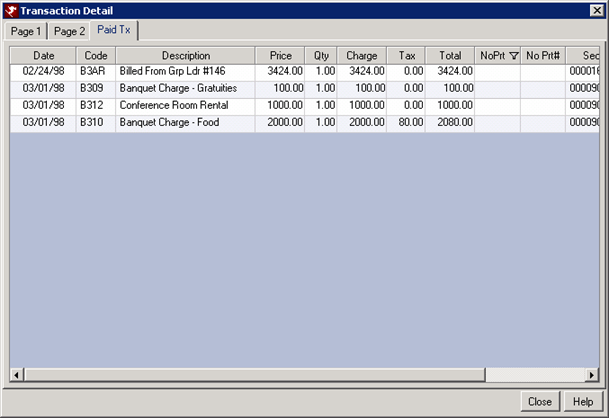
Reservations Tab
Display reservations on the selected group master by reservation
status. Use the drop-down to select a single
status (Future, In-house, Active History, Non-active History, or Cancelled)
or of all active, non-cancelled reservations ("Future, In-House, and
Active"). The entire history of the group is available using various
status searches. Double-click any reservation in the grid to open the Change Reservation
screen.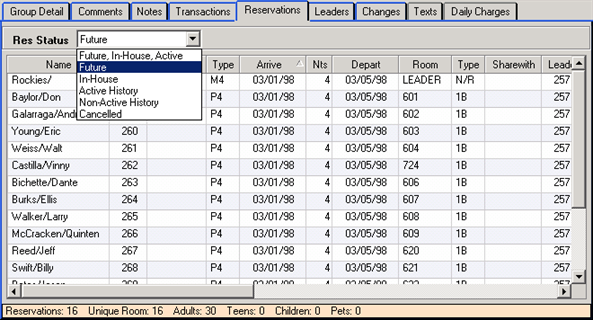
- Res Status
- Use the drop-down to select a single status (Future, In-house, Active History, Non-active History, or Cancelled) or of all active, non-cancelled reservations ("Future, In-House, and Active"). The entire history of the group is available using various status searches.
Leaders Tab
Click the Leaders tab to view existing group leaders for the group
master. Double-click any leader in the grid to view the reservation in
the Change Reservation screen.
- Add
- Click the add button to enter an additional group leader. When
Allow Only One Group Leader is checked on the Group Detail tab, a
warning is displayed.
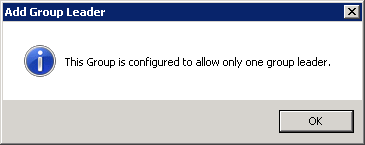
To continue adding another group leader, click the Group Detail tab, uncheck this setting, and return to the Leader tab to proceed. - Change
- Select a leader from the grid and click the Change button to access the Change Res screen. Since a leader reservation can be an actual person in the group or a fake/imitation reservation, change the contacts, Source of Business or Market Code, group Credit Card, and Pay Code information.
- Post Payment
- When the group master balance is a credit, the system suggests using Refund instead of posting a payment; however, the system allows users to continue but opens the Deposit screen and does not allow a negative number to be entered. When the selected group has a balance due, the Deposit screen opens and allows payment to be taken.
Changes Tab
When the Change Tracking Module (S7) is installed, changes made to
group masters in RDPWin are tracked.
Change Tracking Analysis and
Summary
information is also available.
The
system tracks information on the user making the changes as well. Some
properties assign group logons for front desk, audit staff, accounting.
To assure the most accurate information is recorded for Change Tracking,
properties should
create and
maintain individual logons for each and every user. See
Change Tracking Overview for more
details.
- Summary View
- When the Summary View radio button is selected and a group master is
changed using RDPWin, basic change information is
displayed on the tab. Each row in the grid represents a time when
a group was changed and saved. One or many changes can be
associated with a single row. Fields available on this tab
are always Date Changed (includes time), Changed By (based on logon of
user), Name, Group, Type, Balance Due, Pay Code, rate information,
arrival and departure dates, and contact information.
The original vendor record is always displayed at the bottom of the grid. Any changes made thereafter are displayed in order with the latest on top. The grid cannot be sorted, filtered, or reordered. For additional reporting and data manipulation, use Change Tracking Analysis and/or Change Tracking Summary.
When multiple changes are made on the same date and display the same time in the Date Changed grid, view the detail to see the actual, official time including the seconds. - View Detail Button
- While in Summary View, click the "View Detail" button or double-click
any row to display the details on the Changes screen.
The sample screen below shows the group's default rate plan was updated User USER on March 1st at 23 seconds after 3:54 p.m.
- View Group Button
- While in Summary View, click the "View Agent" button to display the
group information in read-only format. The information
displayed is the same as that displayed on the
Change
Group Master screen.
- Detail View
- When the Detail View radio button is selected and a group is
changed using RDPWin, each row represents a single change regardless of whether or not
multiple changes were made during the same Change session. The Date Changed column
is always displayed, along with the field name changed, the original and
new value of that field, and the user's logon information. This
information is the same as displayed on the Changes screen.
Texts Tab
Text messages sent to the group master are tracked on the Texts tab. The grid can be sorted and grouped like other grids in RDPWin. Messages are logged in the Text Log. The group master must have a mobile phone number and the mobile carrier entered on the Contact information section. For more information about text messages, See "Reservations - Text Messaging"

Daily Charges Tab
Daily charges can be set on the group master as the default for all group reservations made using that master. Select the daily charges that apply to the group, and each will reservation except the leader will automatically include these charges on the folio. This saves the user from having to add daily charges to each reservation within the group.
For more information about configuring daily charges, See "Daily Charges"

Click these links for Frequently Asked Questions or Troubleshooting assistance.
04/25/2012
© 1983-2012 Resort Data Processing, Inc. All rights reserved.